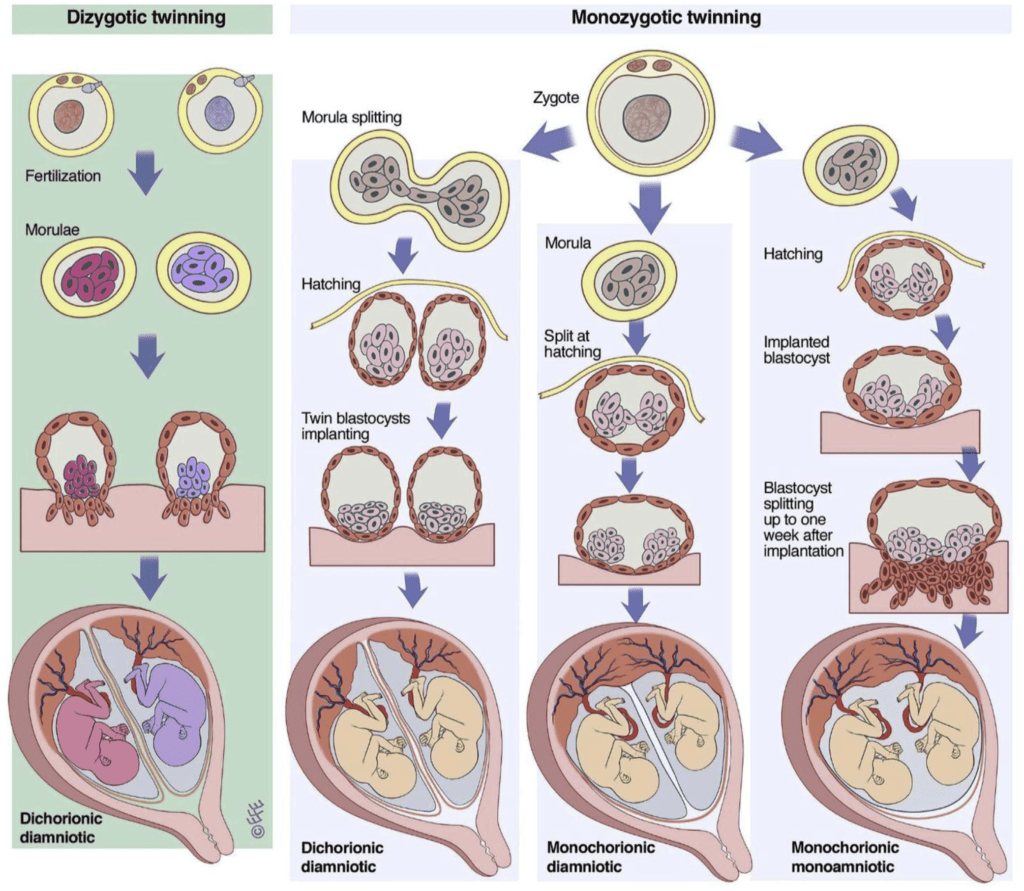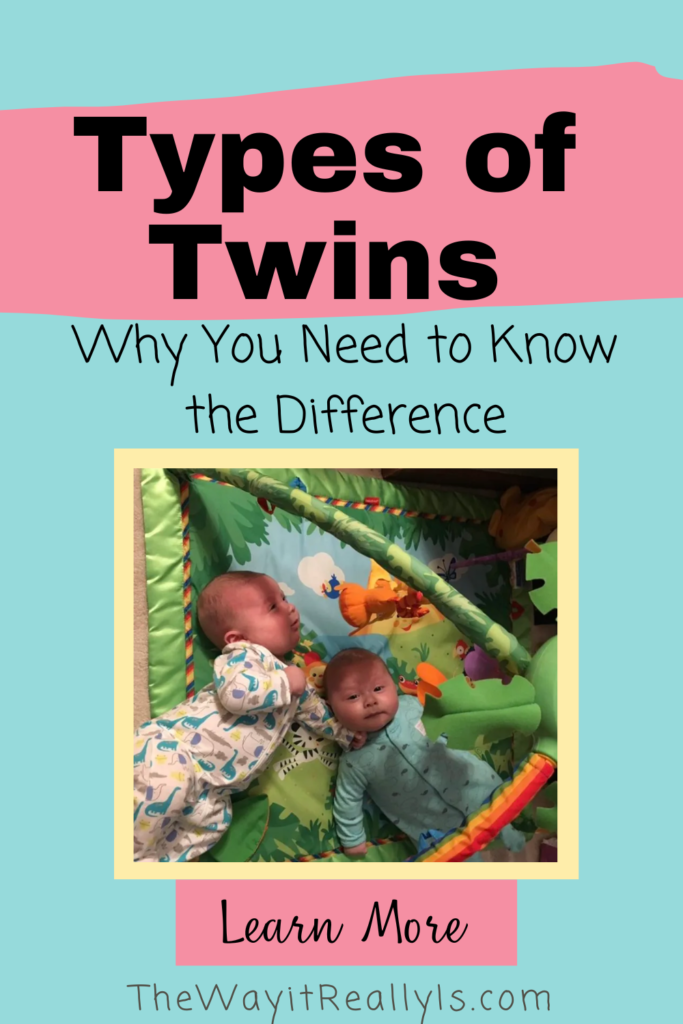Did you know there are more types of twins than just identical or fraternal? In this post I’ll tell you about the types of twins and why it’s important that you know the difference.
I didn’t realize that until I was pregnant with twins and started doing my research, and I’m glad I did since my twins were at higher risk and I needed to be seen more often but my OB didn’t know that.
Table of Contents
Quick Primer on the Types of Twins
Before I was pregnant with twins, I thought there were just identical twins, which I thought just meant they looked exactly alike, and fraternal twins. I was wrong!
There are fraternal twins, who may look alike or not at all, and there are three types of identical twins! Identical doesn’t mean they will for sure look identical but they will likely look similar and came from one zygote that split into two.
Fraternal Twins
Fraternal twins, or Dizygotic Twinning, is when there are two eggs released at the same time and two sperm fertilize the two eggs.
There are two placentas and two amniotic sacs, which makes a fraternal twin pregnancy typically less risky than identical twins.
Fraternal twins can run in families and are the most common type of twins. They can be a result of in vitro fertilization and certain genetic factors such as family history, the mother being over 35, not being a first-time pregnancy, and have had twins in the past.
Only fraternal twins can have one as female and one as male. With any identical twins, they are either both male or both female.
Genetically, fraternal twins are no more similar than any two siblings, other than they have the same birthday (and are still twice the work, don’t get me wrong!) This means that they may have different color eyes, be different sizes, different sexes, and more.
Especially as they get older, people may not believe they are twins, since they look so different. I could see how this would be annoying for the parents and the twins themselves!! One thing I’ve learned with twins is people sure like to comment about them and give their own opinions.
Identical Twins / Monozygotic Twins
Monozygotic Twinning, as shown below, are the three types of identical twins: Dichorionic Diamniotic (DiDi), Monochorionic Diamniotic (MoDi), and Monochorionic, Monoamniotic (MoMo).
With identical twins, only one egg is released and is fertilized by one sperm. Depending on when the fertilized egg, or zygote, splits, determines which type of identical twins are created.
Due to identical twins being from the same egg and sperm, they have identical genetic material, hence being called ‘identical’. It does not always mean they will look completely the same.
Most look rather similar but will surely have their own personalities and quirks.
Identical twins do not run in families, they are completely random.
Dichorionic Diamniotic (DiDi) Twins
Dichorionic Diamniotic (DiDi) twins are identical twins who each have their own placenta and own amniotic sac. DiDi twins split very early in pregnancy and are at the lowest risk of pregnancy complications for identical twins.
Monochorionic Diamniotic (MoDi) Twins
Monochorionic Diamniotic (MoDi) Twins split later than DiDi twins. Due to this, MoDi twins share a placenta and have their own amniotic sacs. They are also sometimes referred to as MCDA twins.
MoDi Twins are at a higher risk for complications since they share a placenta with all the nutrients and blood from mom. I have MoDi twins and wrote more about the possible complications in the blog post linked here.
MoDi Twins are at risk for complications before birth including Twin-to-Twin Transfusion Syndrome (TTTS) and Twin Reversed Arterial Perfusion (TRAP) sequence. Due to these possible complications, MoDi twins are assessed every 2 weeks throughout MoDi Twin pregnancy starting early in the 2nd trimester.
Monochorionic Monoamniotic (MoMo)
Monochorionic Monoamniotic (MoMo) twins are the most high risk pregnancy out of the three because they share a placenta and an amniotic sac.
This means not only is there the concern for equally sharing the resources from the placenta but they can also become entangled in each other’s cords which would lead to strangulation or the cords being so intertwined they can no longer get nourishment from the placenta.
Due to the increased risks, there are significantly more medical appointments throughout pregnancy and often the pregnant woman will be admitted to the hospital around 24 weeks for extra monitoring.
Types of Twins Graphic
The graphic below displays the different types of twins in an easy to understand manner. I’m a visual learner so this helps me a lot at least.
This image isn’t my own, to be honest, I spent a LOT of time trying to make my own but it was no where as good. Originally I found this image at twins.org.au but now I can only find it at another website. Either way, I’m doing my best to show that it is indeed not mine but I wanted to share it with you nonetheless.

Rarer Types of Twins
Beyond fraternal and the three types of identical twins, there are more rare cases of twins including conjoined twins.
Conjoined twins are identical and split later than MoMo twins, to the point they are joined together some place on their bodies.
Frequency of Doctor Appointments
As I briefly mentioned above, with identical twins at least, there will be more doctor appointments than a pregnancy with just one baby. The number of appointments overall will depend on the type of twins and any complications that may arise.
Women pregnant with DiDi Twins require doctor visits every 4 weeks throughout most of pregnancy until 28 weeks then every two weeks until 36 weeks then weekly until delivery.
Women pregnant with MoDi twins require appointments every 4 weeks until 16 weeks when they should start seeing a Maternal Fetal Medicine (MFM) doctor or Perinatal Physician. Basically, a doctor who specializes in high risk pregnancies, including twins. At 16 weeks they should be seen by their specialty doctor every 3 weeks and then starting at 32 weeks they should go every week until delivery. Starting at 16 weeks MoDi twin appointments will include bladder and amniotic fluid assessment every 2 weeks and a growth assessment every 4 weeks. Often, there are 1-2 echocardiograms as well.
Women pregnant with MoMo twins should be seen every 4 weeks until 16 weeks then every 2 weeks. It’s recommended they are admitted to the hospital with daily fetal surveillance between 24-28 weeks.
To learn more about the additional appointments and what will be measured, visit this website.
Trust Your Mama Gut
No matter what type of twins you’re pregnant with, always trust your mama gut if you feel something is wrong.
Conduct your own research about your type of twins and what you should be monitoring, if you doctor or MFM doesn’t tell you specifically. This can be something like gaining more than a pound a day may indicate an issue with MoDi twins or feeling faint or dizzy meaning you have low iron.
When in doubt, call your doctor and/or go into labor and delivery. That’s why they’re there.
You know your body and your babies best. No one else can feel what you’re feeling.
I write more about this in another blog post but had I not trusted my mama gut at 36 weeks pregnant, my twins and I likely wouldn’t be here today.

As a mom of identical twins and a son two years older, I have gained invaluable experience in the realm, and chaos, of parenting. With a Master's Degree and Education Specialist Degree in School Psychology, I spent years as a school psychologist, helping children navigate through their educational and emotional challenges. Now as a stay at home mom and professional blogger, I combine my areas of expertise to help you in your parenting journey.

